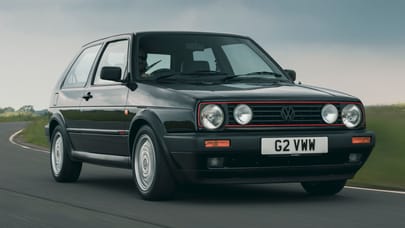
TG’s guide to concepts: the Renault Laguna concept
The mid-engined, turbocharged future mobile from 1990 became Renault’s version of the Lotus Elise


Let’s get this out of the way from the outset – this has nothing to do with Renault’s family-oriented hatch/saloon/wagon that came later on. Of course, how the Laguna concept looks is a bit of a giveaway, as is the way it’s built.
It’s less than a metre tall and weighs just 900 kilos, thanks to an aluminium chassis and a small, 2.0-litre, four-cylinder engine. The low body and half-windscreen idea meant you sat up in the breeze, much like an old F1 car.
Advertisement - Page continues below
So, to prevent a series of eye injuries, both driver and passenger would wear the massive goggles you see here, rather than crouch behind a windscreen. The goggles also housed a set of headphones – and a two-way radio with the passenger – in place of a large, heavy stereo in the car. Yes, the idea is that you look like Judge Dredd every time you drive. Whether this is a good or a bad thing is up to you.

In any case, we get the feeling that the goggles would have been a good idea, because the Laguna’s combination of a 210bhp engine and 900kg kerb weight meant it could do zero to 62 in six seconds and go on to a top speed of 155mph. Which would have been quite breezy.
Advertisement - Page continues below
So, you might be wondering, what came of the Laguna Concept? Well, the name was popular, and was snapped up for Renault’s family car. The mid-engined, lightweight concept, on the other hand, was even more popular – so much so that Renault actually followed through with a road-going version.
The Spider was the first road car built under the Renault Sport name, and followed the low, lightweight mantra of the Laguna Concept to the letter. When it was launched, it came only in a range of primary colours and without a windscreen, heater, exterior door handles, power steering or airbags.

Admittedly, the UK-delivered models came with a windscreen (something about sub-zero temperatures and Welsh B-roads) and a roof, of sorts, but one you could only use up to about 55mph, when it would disintegrate.

So, it was as uncompromising as the concept and every bit a product of the 1990s. It’s also Renault’s last road-going, rear-drive performance car – at least until the Alpine finally, finally debuts.

And, if this isn’t enough to satiate your appetite for conceptual Renaults, check out some of Renault’s best concepts.
Advertisement - Page continues below
Trending this week
- Car Review
BMW 1 Series
- Top Gear's Top 9
Nine dreadful bits of 'homeware' made by carmakers







